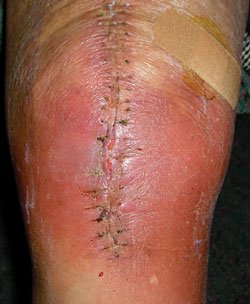Synovial fluid WBC count highly useful in detecting early postoperative TKR infection
The Knee Society’s Mark Coventry Award paper explored whether usual tests can help diagnose periprosthetic infection at 6 weeks postoperative.
NEW ORLEANS — An acute postoperative infection following total knee replacement is a difficult diagnosis for the orthopedic surgeon to make. A recent multicenter, multisurgeon study, however, provides some guidance.
Based on the studies findings, surgeons should strongly consider aspirating the joint and obtaining a synovial fluid white blood cell (WBC) count and differential in addition to standard cultures, if there is suspicion for a deep periprosthetic joint infection. Further, while the erythrocyte sedimentation rate (ESR) was not very helpful for identifying an infection, other easily obtained serologic tests were.
“The C-reactive protein (CRP), even in the early post-operative period, was very helpful … The synovial fluid white blood cell (WBC) count, however, was the best test,” Craig J. Della Valle, MD, of Chicago, said.
|
|
Della Valle, a member of the Orthopedics Today Editorial Board, presented the findings at the Knee Society Specialty Day Meeting held here during the 2010 Annual Meeting of the American Academy of Orthopaedic Surgeons.
For their research, which was a collaboration between Rush University Medical Center and Jefferson University Hospital in Philadelphia investigators, Della Valle and colleagues including Hany Bedair, MD, Nicholas Ting, Mario Moric, Arjun Saxena, MD, Christina Jacovides and Javad Parvizi, MD, FRCS, received the Knee Society’s Mark Coventry Award.
Investigators identified 146 knees at their institutions that were aspirated at a mean of just under 17 days postoperatively for suspected infection within 6 weeks of total knee replacement (TKR); 19 knees were eventually found to be infected and 127 knees were not.
|
Image: Della Valle CJ |
Analyzed synovial fluid
Concerned about the inaccuracy of standard values typically used to identify infected TKRs outside of the first 6 weeks postoperatively, Della Valle and colleagues analyzed the value of the ESR, CRP, and synovial fluid WBC count with differential for each patient and found a mean of 92,600 WBC/µl in the synovial fluid of infected knees vs. 4,200 WBC/µl in noninfected knees (P<0.001).
Stressing the usefulness of synovial WBC count and differential, Della Valle said, “Using a threshold of approximately 10,000 WBC/µl is going to have a very good negative predictive value. It is a good rule-out test. With a value of approximately 27,800/uL, the synovial fluid WBC count is a good rule-in test with a very good positive predictive value. It is important to recognize these values are very different than the thresholds we would use for diagnosing chronic periprosthetic infections which hover around 1,800 to 3,000 WBC/uL.”
ESR vs. CRP
“We found the ESR to have poor predictive value, but again the CRP was significantly higher in patients who had an infection,” he said. Based on these findings, if the clinician is unsure if an aspiration is warranted, the CRP can assist with this decision. He recommended using a value of about 100 mg/L as a CRP threshold for suspicion as the mean CRP was 171 mg/L in the infected group and 88 mg/L in the uninfected group. Receiver operating curves identified 95mg/L as the optimal trade-off between sensitivity and specificity.
When reviewing the data, the investigators found a strongly bi-modal distribution of data points, with the majority of, synovial fluid WBC counts being either way above or below the proposed benchmarks.
When asked during the discussion period how to manage patients with counts that are in the mid-range, Della Valle suggested evaluating the differential (the optimal cut-off point was identified as being approximately 90% polymorphonuclear cells) or if the clinical picture and laboratory values are still unclear, admitting the patient for observation and using antibiotics while waiting for results of the aspirate cultures to come back. — by Susan M. Rapp
Reference:
- Della Valle CJ, Bedair H, Moric M, Ting N, Jacovides C, Saxena A, Parvizi J. Diagnosis of early post-operative infection following total knee arthroplasty: The utility of synovial fluid cell count and differential. Presented at the Knee Society Specialty Day Meeting. March 13, 2010. New Orleans.
- Craig J. Della Valle, MD, can be reached at Rush University Medical Center, 1725 W. Harrison St., Suite 1063, Chicago, IL 60612; 312-432-2350; e-mail: craigdv@yahoo.com.
The investigation entitled, “Diagnosis of Early Postoperative Infection Following Primary Total Knee Arthroplasty: The Utility of Synovial Fluid Cell Count and Differential,” by Della Valle and colleagues is an excellent contribution to this diagnostic and therapeutic challenge for orthopedic arthroplasty surgeons.
It is not uncommon for a patient to follow-up with their surgeon during the first 6 weeks after surgery with pain and an erythematous surgical incision. Early and aggressive surgical debridement is indicated if an infection can be documented, but if the prosthetic joint is not infected then surgical treatment is not indicated and risks untoward events and further complications.
Surgeons must be aware the laboratory findings noted in the study are relevant for the first 6 weeks. The synovial white blood cell (WBC) count of more than 27,800 wbc/mcl with a differential of more than 89.6% is the cutoff for diagnosing an infection. The study does provide this objective data that will aid in the management of this challenging problem. Surgeons must also be aware that the laboratory findings do not apply to other postoperative intervals.
— Kevin L. Garvin, MD
Professor and Chair,
Department of Orthopaedic Surgery
University of Nebraska Medical
Center
Omaha, Neb.


